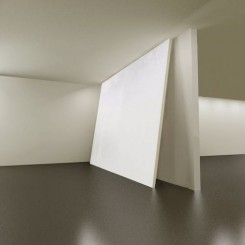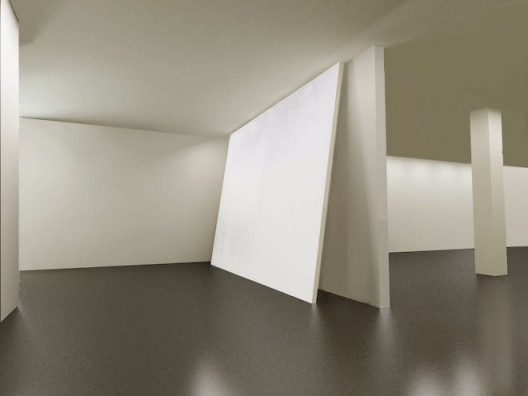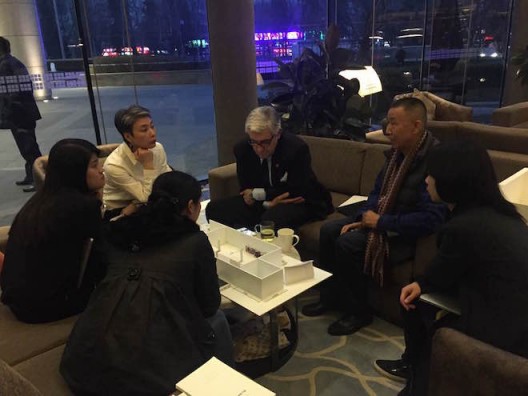Solo Exhibition
Pearl Lam Galleries
At Yuan ArtMuseum
Exhibition Dates: 2016.4.28 – 7.27
Venue: Yuan Art Museum, 112 Lizexiyuan North Guangshun Street Wangjing Chaoyang District, Beijing, China
Beijing—In 2016, as Yuan Art Museum enters a new phase of development, the museum is honored to present a solo exhibition by Zhu Jinshi from April 28 to July 27, curated by Walter Smerling, a well-known Germany-based curator. In this exhibition, Zhu examines the commonalities and fluidity between painting and installation art through works that traverse the boundaries of both.
Zhu Jinshi’s artistic practice is not confined to just one medium. He creates sculptural thick paintings and large-scale installations in a dialogical undertaking of the two. His paintings surpass the flatness of a pictorial surface and subvert the conventions of painting with its own medium, pigment, while his installations mostly incorporate materials used in painting—plain and rustic linen, pigment, frame, rice paper, and ink. Led by conceptual spatial arrangements, the materials mediate the artist’s inquiry into the fundamentals of his artistic language and go beyond their innate cultural implications.
Zhu Jinshi’s rumination on the overlap and interchangeability between painting and installation began as early as 1990, when he had his first solo exhibition after moving to Germany. In the exhibition, Zhu presented one of his paintings along with its crate as installation art; some other paintings were displayed with the backs of the canvases facing forward after they were completed in the studio. Previous to this exhibition, Zhu initiated Fang Zhen Project, where he exhibited a cubic meter of linen and a cubic meter of rice paper, respectively in Berlin and Beijing in 1988.
“By the end of 1980s, I thought that the only way I could discover the essence of art was to give up painting, which led to my interest in other art forms, as well as my creation of installation art. But in 2000, my perception of art shifted. I wanted to solve the mystery left by Marcel Duchamp.” —Zhu Jinshi
Zhu Jinshi picked up his paintbrush again around 2000. At the time, his approach to painting was a criticism of the medium itself, and the dialectic conversation between the confinement and fluidity of medium carried over to his installation art. In the current exhibition, Zhu regards all his artworks as one large piece, which showcases his experimentation with the interchangeability between painting and installation. The exhibition is divided into four sections: conceptual painting, installation, abstract painting, and painting installation.
Upon entering the exhibition space, viewers will come across a gigantic blank canvas leaning against a wall. The size of the frame exceeds the height of the ceiling, and the surface of the canvas has been varnished with wall paint even though it has already been coated with a base layer of oil paint in the studio before being exhibited. This work challenges the concept of painting in terms of spatial placement and visual effect, exploring how the two interact. The idea of “strolling in-between” the representation of painting is encapsulated in the installation of three hundred frames exhibited in the center of the gallery (L17.1 x W1.6 x H1.8 m), splitting the exhibition space in half, only leaving an exit at the end of the hall. While these two works push the boundaries of painting and installation, they also indicate Zhu’s re-embracement of painting in the disguise of installation, where painting materials are often utilized.
The tension between painting and installation is further realized by the concept of “compressed painting”, proposed by Walter Smerling. Five quadriptychs (each 180 x 640 cm) hang on two facing walls in the exhibition space with an installation of six tons of canvases compressed together, placed in the middle of the room, parallel to the walls. After experiencing the tension between pigment, frame, and canvas played out in the exhibition area, viewers enter the last room in the museum where one hundred yellow paintings—with three centimeters of pigment on top—are laid out on the ground instead of on the wall. In a calm, rational, and minimalist atmosphere, the paintings seem to ask “what are the possibilities of representation for painting?”
Zhu Jinshi
Zhu Jinshi (b.1954) is a pioneer of Chinese abstract art and installation art. He began to create abstract paintings in the late 1970s and moved to Berlin in 1986. Since then, he has been experimenting with performance, installation, and conceptual art. In 1994, Zhu returned to China, dividing his time between Berlin and Beijing until 2010. At present, he lives and works in Beijing.
Zhu’s selected recent solo exhibitions include Zhu Jinshi (2016), Blum & Poe, New York, New York, USA; Performance in Paint: Zhu Jinshi (2015–16), Inside-Out Art Museum, Beijing, China; the special installation project Boat (2015), Pearl Lam Galleries in collaboration with Hongkong Land at Exchange Square, Hong Kong, China; Simplicity (2014), Pearl Lam Galleries, Singapore; Zhu Jinshi: The Reality of Paint (2013), Pearl Lam Galleries, Hong Kong; and Zhu Jinshi (2012), Blum & Poe, Los Angeles, USA.
Recent group exhibitions include 28 Chinese (2015), Asian Art Museum San Francisco and San Antonio Museum of Art, USA; Perfection by Chance—A Yi Pai Series Exhibition (2015), Pearl Lam Galleries, Hong Kong, China; and Thick Paint: Jean Fautrier, Franz West, Zhu Jinshi (2014), Luxembourg & Dayan Gallery, New York, USA.
Zhu Jinshi’s works have been collected internationally by notable public and private collections.
Yuan Art Museum
Yuan Art Museum, formerly named Yuan Art Center, was founded by Gu Yan in 2008 and renamed in 2010. To this date, Yuan Art Museum has shown more than twenty influential exhibitions, featuring both Chinese and international artists, including After Culture—Exhibition of Chinese Contemporary Painting, Spring Equinox, The Great Celestial Abstraction, and Re-Present. The museum has become one of the most active non-profit art institutions in Beijing. Under the leadership of Museum Director Joshua Kim, who assumed the position in 2016, the museum has increased its international profile and caliber of exhibitions. Yuan Art Museum also collaborates with other museums, art foundations, galleries, media, and collectors to build a superior exhibition space for the public.
Walter Smerling
Walter Smerling (b.1958) did a banking apprenticeship, as well as university studies in Business Administration and Art History, before becoming a graduate trainee at the SWF television broadcasting company. He subsequently became active as an author, director and presenter of television films, with a focus on cultural documentaries and artist portraits. Parallel to this, he also made a name for himself as an organizer and curator of numerous exhibition projects, discussion events, and artist talks. He has curated major exhibitions such as 60 Jahre / 60 Werke, Art and Press, Yad Vashem—Art from the Holocaust, and China 8. Currently, he is planning one of the most comprehensive exhibitions on contemporary German art in Beijing for 2017.
Smerling is Chairman of the Executive Board of the Foundation for Art and Culture in Bonn, Director of the MKM Museum Küppersmühle of Modern Art in Duisburg, and Artistic Director of the Salzburg Foundation. In 2007, he was awarded an honorary doctorate from the University for Art and Design in Cluj-Napoca, Romania. In 2010, he was named Honorary Professor for Art and Culture in the Faculty for Cultural Reflection at the University of Witten/Herdecke.


